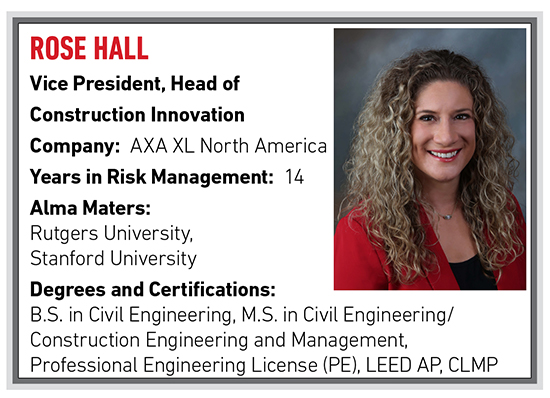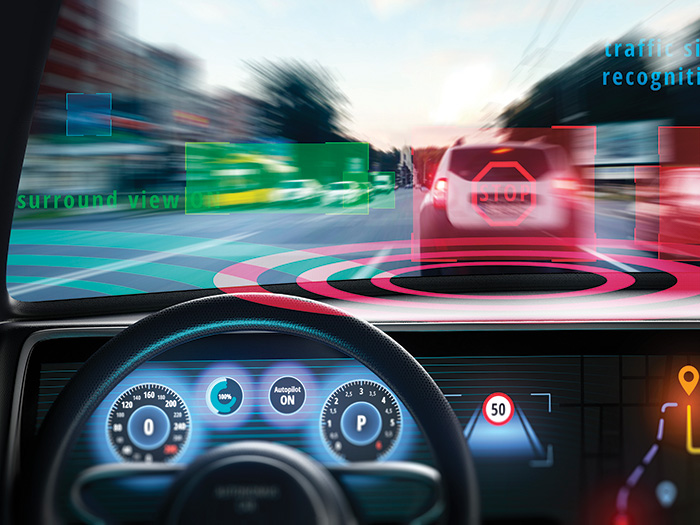This Engineer-Turned-Risk-Manager Talks New Technologies, Collaboration and Working in the Construction Industry as a Woman

R&I: What was your first job?
My first job was a design engineer intern at a company called Bohler Engineering. Interestingly enough, after 12 years in business, I was the first female engineer they hired.
R&I: How did you come to your current position?
I transitioned from construction operations into risk management while I was at Turner. I spent the first, almost decade of my career in construction and engineering and after a couple of years there going through the ranks, I was invited to interview for a position in the Turner risk management group, which at the time it seemed weird to interview with a company you already worked for, but it was a very, very different job.
I had to think very hard about whether I wanted to leave the field for a career in risk management. I thought it sounded interesting so I took the opportunity and never looked back.
R&I: What’s been the biggest change in risk management and the insurance industry since you’ve been in it?
I would say collaboration and sharing of best practices. I recall about 20 years ago, construction companies with risk management departments were holding their best practices very close to the vest, because they felt that was a competitive edge.
Fast-forward to now, and they’re all sharing best practices with each other. Many are friends, and most are at least acquaintances.
There’s a solid collaborative community, born out of the realization that they can be greater than the sum of their parts when they work together. They all understand risk in the construction industry in a deeper way than ever before – which leads to the biggest change I’ve seen in the insurance industry … which is the structured sharing of risk.
The more contractors mature in their understanding, measurement, and control their risks, the more willing they are to take on more risk and reap any associated rewards. Risk management used to mean “buy insurance to cover it.” Now it’s really about strategically deciding which risks to transfer and which to retain for the best overall result.
What has evolved is customers assuming greater deductibles and self-insured retentions, and some even have their own captive programs. This new interest in shared risk drives the evolution of the construction insurance landscape to meet a new market need.
R&I: What’s the biggest challenge you’ve faced in your career?
I’ve been fortunate to have had many opportunities and positive experiences as a female in engineering/construction. But like most, overcoming the perception that females don’t know anything about construction, is probably the biggest challenge I faced when I was younger in my career.
I remember walking into boardrooms and people saying, ‘who brought the kid?’ And I don’t think they would have behaved the same way if I was the same age, but a man.
I don’t feel like the stigma is quite as strong as it used to be, but I would say that’s the biggest challenge. Honestly, it’s the biggest opportunity though too, because I’ve had people pick me out because I stand out, because I am the only female in the room.
So, it depends on your audience. If your audience comes from a fixed mindset where they expect to see one type of person as their construction manager, and they’re just not open to anything else, then there’s the challenge. If you walk in and they are pleasantly surprised that you look different than they expected, then it’s an opportunity.
R&I: Who has been your mentor(s) and why?
I’m proud to say that my greatest mentors are also some of my closest friends. A few that come to mind are Chip D’Angelo (an environmental consultant and entrepreneur), and TJ Lyons (a brilliant safety professional).
When you form a connection with someone who’s a bit ahead of you in their career and they believe in you and they see themselves in you, or at least a little piece of it, they’ll support you to the ends of the earth. Those are the gems you hold on to.
R&I: What is the risk management community doing right?
Forming a community and sharing best practices, and getting creative about how to be more profitable using risk management, rather than simply viewing “risk management” as purely “risk transfer”.
R&I: What could the risk management community be doing a better job of?
I would say the next place the risk management community could look to advance is keeping up with the modernization of our world.
There are two different kinds of innovation – sustainable innovation, which is when make your current product slightly better, and there’s disruptive innovation, which is scrapping the whole first product and creating something completely new and different that solves the same problem.
If the problem is hailing cabs in NYC, a sustaining innovation would be a whistle, which helps to hail cabs more quickly and efficiently and from further away than a traditional hand wave. Whereas, the disruptive innovation would be Uber.
Risk management, insurance and construction are all legacy industries that tend to lean toward sustaining innovation – especially in the commercial market. However, there are some personal lines insurance companies that have taken on this challenge and disrupted the insurance industry with tech-enabled, customized, and instant insurance solutions.
I think that the commercial market could take a lesson from the consumer market. And yes, it’s more complex to write business-to-business insurance than it is business-to-consumer, but it’s still people-to-people in the end – and disruptive companies are showing us it can be done.
I think we can create streamlined models of what we do now and just make everything simpler. Let’s not look to build the next version of what we have now. Let’s build a completely new thing that meets the needs of today’s world.
R&I: How would you say technology has impacted the risk management profession?
I think so far, we’re not completely sure what to do with it yet, as an industry (both construction and insurance). We know that it’s beneficial. We know that automating things that are typically manual is safer, more efficient and allows us to capture and analyze metrics in ways not previously possible – however turning data into insights and then into action is the challenge we are currently facing.
I’ll speak specifically about construction. The more humans you can remove from harm’s way, the fewer injuries you’re likely to have. Therefore, automating certain tasks through technology and/or robotics is inherently more safe.
I think as a whole, we struggled to figure out how to do that. There’s so much tech out there – it’s very fragmented. There are a lot of players in the space that are tech savvy, but not risk management, insurance, or construction savvy – and every conceivable combination, but hardly anyone who has expertise in the cross-section of all those industries to guide the way.
It can be difficult to tell what’s real and valuable technology that’s going to be impactful, and what’s just blinky, shiny, and cool. This is why we’ve developed our AXA XL Construction Ecosystem. We’re helping customers find and adopt technology that benefits their risk management needs, and ultimately their business goals.
R&I: With a plethora of new risk management technologies on the market, how can risk managers determine what solutions will work best for them?
My current role was built to support our contractor customers’ technology adoption in a meaningful way. Because we work with most of the top contractors, we have a privileged cross-sectional view that they can’t see from where they sit.
And because we write their insurance and risk engineer their accounts, we know their businesses – we know how they manage risk, where they excel, where they need support – and they trust us to provide them with feedback and recommendations to get them to the next level, up to and including technology.
Right now many of these contractors are trying to test and pilot thousands of tech solutions one by one, which is extremely fragmented and completely inefficient.
Since we are their partner in risk (and therefore have skin in the proverbial game), we figure we can help with this by sharing best practices and technology learnings, providing a forum for them to share with each other so they all learn, test, and try faster. But first, you’ve got to connect them and provide standards and a benchmarking process for metrics. You can’t manage what you don’t measure. So, that’s what we’re doing here with our Construction Ecosystem.
Our Construction Ecosystem is an interconnected way for our customers to be able to discover tech, talk with each other about the different experiments and technologies that they’re using. Talk with us about it, and then potentially get benefits from us on, on risk reduction.
For example, our Highly Protected Projects (HPP) is where we pair technology with a policy and offer preferred terms, rates or deductibles as appropriate. This is one way we’re supporting tech adoption and reward contractors for being tech-forward.
We’ve also got what we call our TAMI (Technology Adoption Maturity Index), a risk engineering service where we assess a contractor’s level of technology adoption maturity against their peers and provide them with a report and recommendations on the next technologies to explore.
Construction is a competitive industry, and by capitalizing on this culture, we are able to encourage technology. Trust me when I say that a contractor who receives a TAMI score of 3.5 when their peer scores a 4.5, their first question will be ‘how do I get through a 4.6?’. This is where we can help them find technologies that help raise the bar, help them become more technologically mature, and of course, chase down their peers in the tech adoption journey!
R&I: What’s your favorite book or movie?
It’s a book by Mark Manson called The Subtle Art of Not Giving A F*ck. It’s a book about what’s important in life and what’s not.
If you think about things you care about, when we “give a care” about way too much stuff, it makes us nervous and anxious and scared and fearful and afraid to try new things. But if we can parse out what’s important in life and what we should really give our cares about and what we should just let pass us by. There’s peace in that.
R&I: What is your favorite drink?
A dirty martini (vodka), with blue cheese stuffed olives – and I’m not precious about shaken or stirred!
R&I: What have you accomplished that you are proudest of?
I completed Lake Placid Ironman in 2012. That’s a 2.4 mile swim, a 112 mile bike, and then a 26.2 mile run (marathon). Having been a runner all my life, picking up biking and swimming was a challenge. And the training was hard – really hard – sometimes 20+ hours per week. But by the time you’re trained up, race day is just so much fun. It doesn’t feel hard at all.
R&I: What is the riskiest activity you’ve ever engaged in?
Cave scuba diving the Cenotes in Mexico. It’s one thing to go scuba diving in the open water where you can see the surface.
It’s another thing to go scuba diving in a dark, narrow cave where you’re following a rope line and navigating with a compass and a flashlight (that you hope has enough battery life!). It was beautiful – but definitely risky and frightening. &










